Known for burying Pompeii in a massive eruption during Roman times, Mount Vesuvius holds a perilous reputation with an eruption cycle of approximately 20 years, last erupting in 1944. A mere 22 kilometres from the modern city of Naples and 25 kilometres from Pompeii, it continues to draw tourists worldwide, despite its risks. Adding to its allure, Mount Vesuvius offers numerous hiking trails, attracting to outdoor enthusiasts. The most popular route guides visitors to the highest reaches, culminating at the crater rim.


I’ll break down our day trip to the Crater of the Active Volcano Mount Vesuvius into the following sections:
- How we reached Mount Vesuvius
- Entered the national park area at the Piazzale
- Climbed up to the crater
- Learned insights about the crater
- Walked around the rim of the volcano crater
- Marveled the panoramic vistas from the summit of Mount Vesuvius
- Enjoyed a late lunch on the slope of Mount Vesuvius
How we reached Mount Vesuvius
Parking by the Roadside
Our journey along the A3 motorway led us to the Ercolano exit, and from there, we followed the provincial road Ercolano-Vesuvio to reach the entrance of the crater. However, private vehicles were restricted from proceeding to the road’s end. Instead, we took a turn into Strada per Belvedere Vesuvio (Belvedere della Seggiovia) and found a spot to park along the roadside.
The parking fee was a few Euros (the exact amount escapes me) per day. This particular parking area might not be readily visible on Google Maps, but if you switch to satellite view, you’ll spot cars lining the street.
Boarding the Shuttle Bus to the Ticket Office
Upon collecting the parking fee, the attendant informed us about the shuttle bus service to the ticket office, departing from the parking area. Keep in mind that this shuttle service isn’t complimentary; it costs two Euros for a round-trip ticket. Within a few minutes, the bus brought us to the lower slope of Mount Vesuvius, a common drop-off point for most buses.
Exploring Alternative Routes to Mount Vesuvius
The journey from the motorway exit to this drop-off spot took us over an hour, and we still hadn’t obtained our entrance tickets. Depending on your accommodation location, it might be more convenient to consider one of the available tours, some of which also include visits to other nearby sites.
Entered the national park area at the Piazzale
Guidance at the Information Board
At the bus stops, a sizeable information board captures attention, presenting a detailed layout of all the walking trails encircling the craters. According to the official website, the national park offers a choice of nine walking trails. Of these, the No. 5 trail stands out as the most favoured among visitors, winding its way around the crater rim.
Get the tickets.
Surprisingly absent was any visible ticket office or a sign pointing towards ticket office. A person stationed by the roadside seemed to take on the responsibility of ticket sales, a role many tourists entrusted him with. He also enlightened us that the entrance ticket to the national park covered the crater visit as well.
Shops and Toilet
A few hundred meters down the road, we came to an unpaved square, known as Piazzale. Here, a shop tempted passersby with souvenirs, simple snacks, and drinks. While the toilets left much to be desired—lacking both cleanliness and essentials like paper and water—it was a chance worth seizing, as no facilities were available beyond the entrance barrier.
Climbed up to the crater
We began hike from the entrance towards the crater. A helpful individual offered walking sticks for a nominal fee of one Euro each. Given my previous leg injury, I decided to rent one to provide additional support on the trail. Covering the distance from the entrance barrier, it took approximately 30 minutes of hiking to reach the desolate summit.
This stretch is not particularly difficult but quite steep. It is on the surface of the volcanic rocks and stones from the eruption. The air temperature in mid-October was around 24 degrees. There is no shade along the way until we reached a small kiosk, where a tiny shade with several seating places is available. We took a rest there while enjoying the view of the coast area.
While not excessively challenging, this section proved notably steep, crossing the surface of volcanic rocks and stones from past eruptions. In mid-October, the air temperature hovered around 24 degrees. The trail offered no respite from the sun until we reached a small kiosk. Here, a meagre shade with a few seating spots invited us to take a well-deserved rest while relishing the panoramic view of the coastal area.
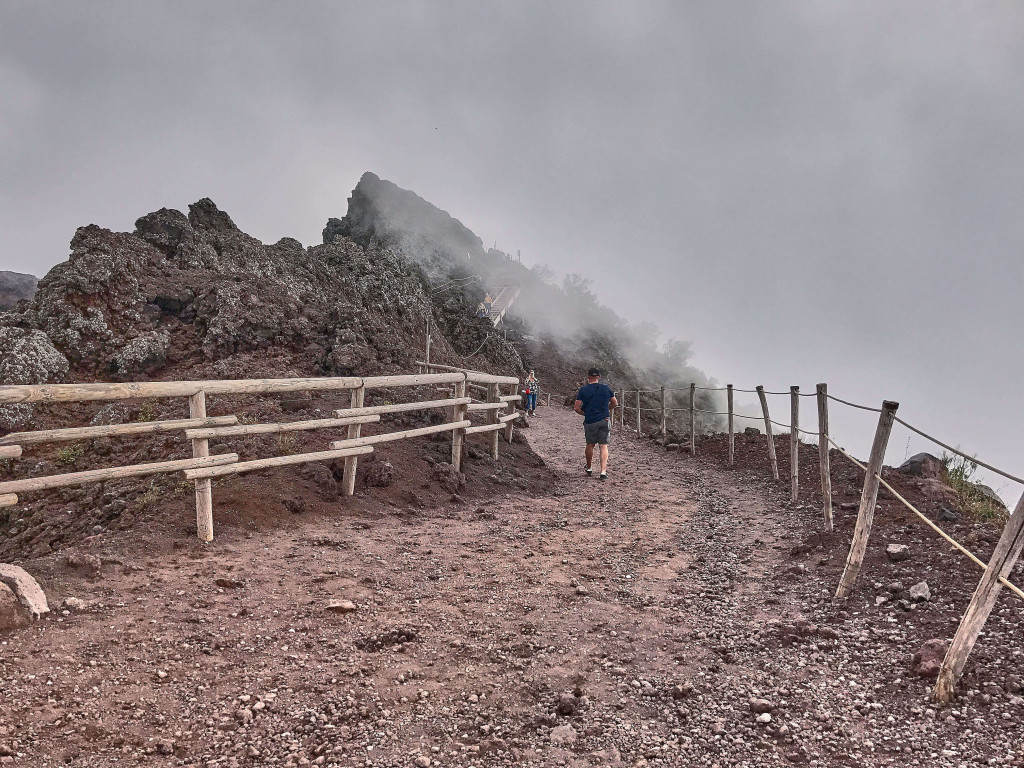
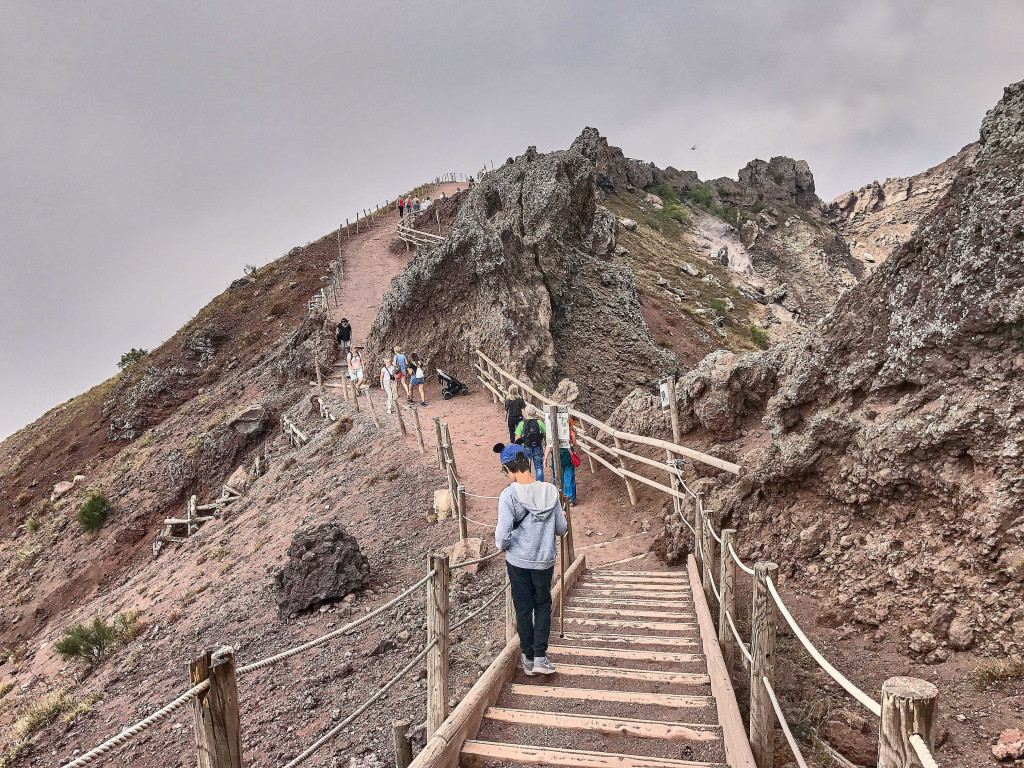
Learned insights about the crater
The size of the crater
Beyond the kiosk and a few steps ahead, we finally reached the crater, resembling a colossal cone with a current diameter of 450 metres and a depth of 300 metres. Steaming vents inside the crater caught our attention, surrounded by black ash and lava rocks that cloaked the volcano’s slopes.
Recalling Catastrophic Eruptions in AD 79
In the aftermath of the catastrophic eruptions in AD 79, the volcano ejected a cloud of ashes and volcanic gases, propelling molten stones and pulverized pumice at a staggering rate of 6×105 cubic metres per second. This unleashed a scorching lava avalanche that cascaded down the hill, claiming the lives of thousands and burying the cities of Pompeii and Herculaneum.
Historians and scientists assert that the thermal energy released during the eruption was a 100,000 times greater than the thermal energy of the Hiroshima-Nagasaki bombings.
Ongoing Research
Notably, a group of researchers diligently conducted their studies at the crater’s bottom. Mount Vesuvius stands as one of the most extensively researched volcanoes globally. Just two kilometres from the crater, along the main road, the Vesuvius Observatory Museum exhibits things related to Mt. Vesuvius and volcanology research, including studies on terrestrial magnetism. This site marks the location of the initial seismic and volcanological research, where scientists tested various measuring instruments.
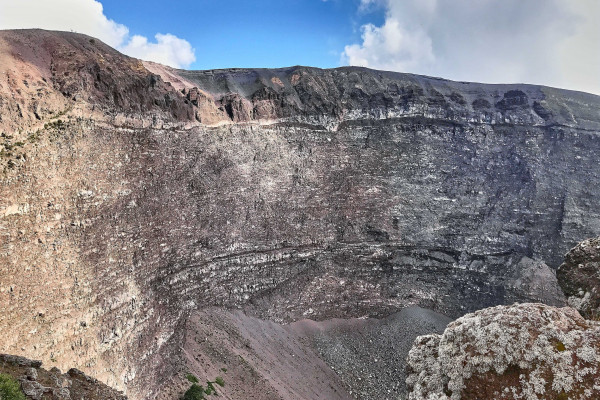
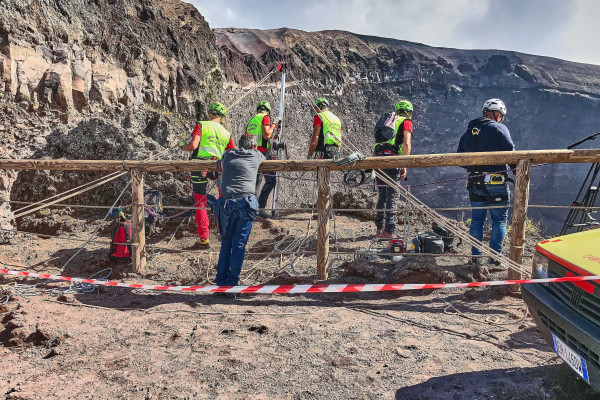
Walked around the rim of the volcano crater
The hiking trail around the crater
According to the map, Trail No. 5 encircles the rim of the crater. Wooden staircases emerged at various points, adding a sense of adventure into our journey. Occasionally, we caught whiffs of sulfur gases wafting from the steaming vents. After covering a few hundred meters along the rim, our hike came to an unexpected halt. The trail seemed to abruptly end, and the reason behind this sudden end remained a mystery to us.
The ruins of the funicular
Next to the crater was the ruins of the original funicular cable car, inaugurated in 1880. In the past, a railway led to the lower station of the cable car, providing an alternative to the arduous climb to the Vesuvius summit. Unfortunately, the cable car succumbed to destruction during the eruption of March 1944, leaving only ruins behind.

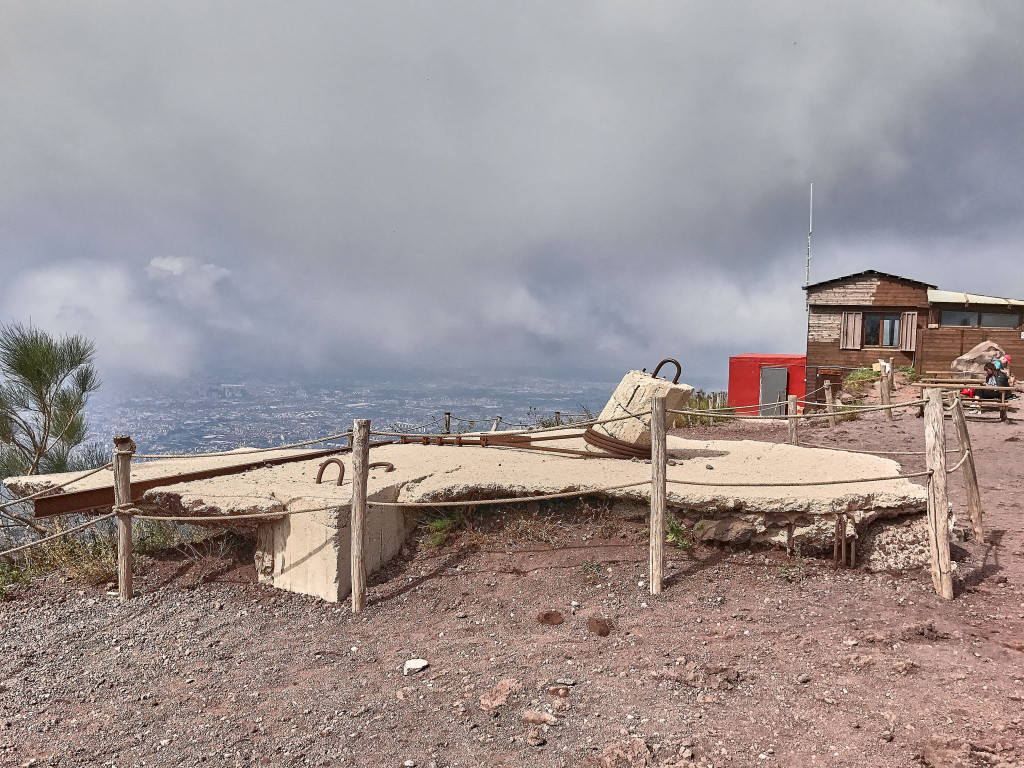
Marveled the panoramic vistas from the summit of Mount Vesuvius
The views from the Vesuvius summit were truly spectacular! From there, we could gaze out over the Bay of Naples and the Campanian Plain. On that clear day, the panorama offered a breathtaking 360-degree view of the surroundings, even allowing us to spot Capri in the distance. With a professional camera, one could capture details like the ruins of Pompeii.
It’s fascinating to think that, before the catastrophic eruptions, the coastline was much closer to the land, and today’s densely populated area was shaped by the volcano’s ashes. The proximity of millions of people living near this active volcano is both astonishing and concerning. Steaming vents serve as constant reminders that Vesuvius will inevitably erupt again. As I felt the volcanic gravel crunching beneath my feet, I couldn’t help but wonder about the evacuation plans in place.
Suddenly, gusts of wind swept across the crater, and clouds began to move towards us. Feeling a bit cold and hungry, we made the decision to walk back to the parking lot and then drive to the Terrazza Due Golfi restaurant halfway down the slope.

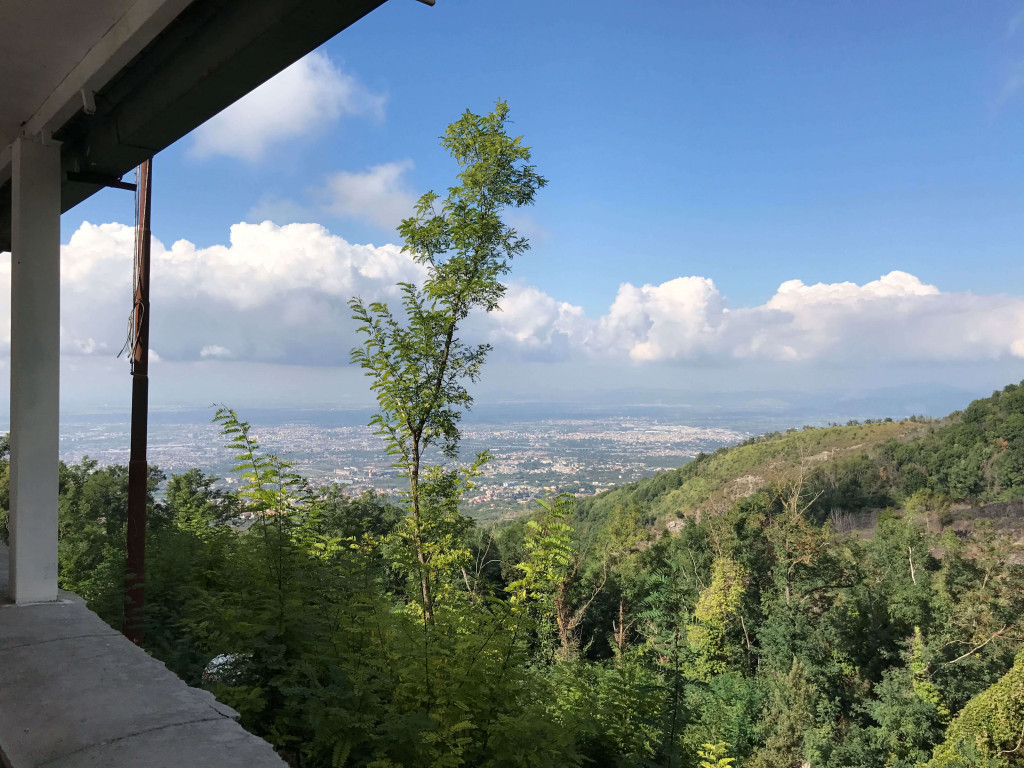
Enjoyed a late lunch on the slope of Mount Vesuvius
The restaurant on the volcano slope
The eatery perched on the slope of the volcano, Terrazza Due Golfi, treated us to an outdoor rooftop dining experience with a splendid view overlooking the bay. Their menu offered dishes, ranging from Antipasti and pizza to seafood pasta and delectable desserts.
To our pleasant surprise, a bottle of wine was priced at a mere 10 Euros. At the adjacent table, a group of fellow tourists had already drunk several bottles and went on to order another, specifically the celebrated Neapolitan wine, Lacryma Christi D.O.C., produced on the slopes of Mount Vesuvius.
The wine produced on the volcano slope
Lacryma Christi D.O.C., translating to “tears of Christ,” has been a product of the region since Ancient Roman times. The vines, deeply rooted in the dark and porous lava-rich soil, naturally retain and release humidity as needed. We leisurely savored our late lunch paired with this special wine, all while soaking in the magnificent view. Truly, it marked the perfect end to a wonderful day of hiking!
Travel tips
Things to know before visiting Vesuvius
- Ensure your footwear is comfortable for the climb up the crater; flip-flops, sandals, or ballet flats won’t be your best companions on this journey..
- Expect cooler temperatures at this altitude of approximately 1,000 meters compared to the coastal areas. It’s wise to check the weather beforehand and possibly bring along rain gear. Be well-prepared with layered clothing..
- Climbing the crater is only permitted under safe weather conditions. Before your adventure, check the opening times on the national park website to ensure a seamless plan.
- Keep in mind that a hat, sunscreen, and ample water supply will be essential, given the trail offers no shade.
- Consider taking the shuttle bus, especially since the ascent from the parking area to the ticket office can be quite challenging. This way, you’ll conserve energy for the actual trail..
How to get there
In the “How to get to the Crater” section on the national park website, detailed instructions are provided for reaching the destination by car, train, buses, or taxis. Alternatively, you can check this local website for specific bus connection details.
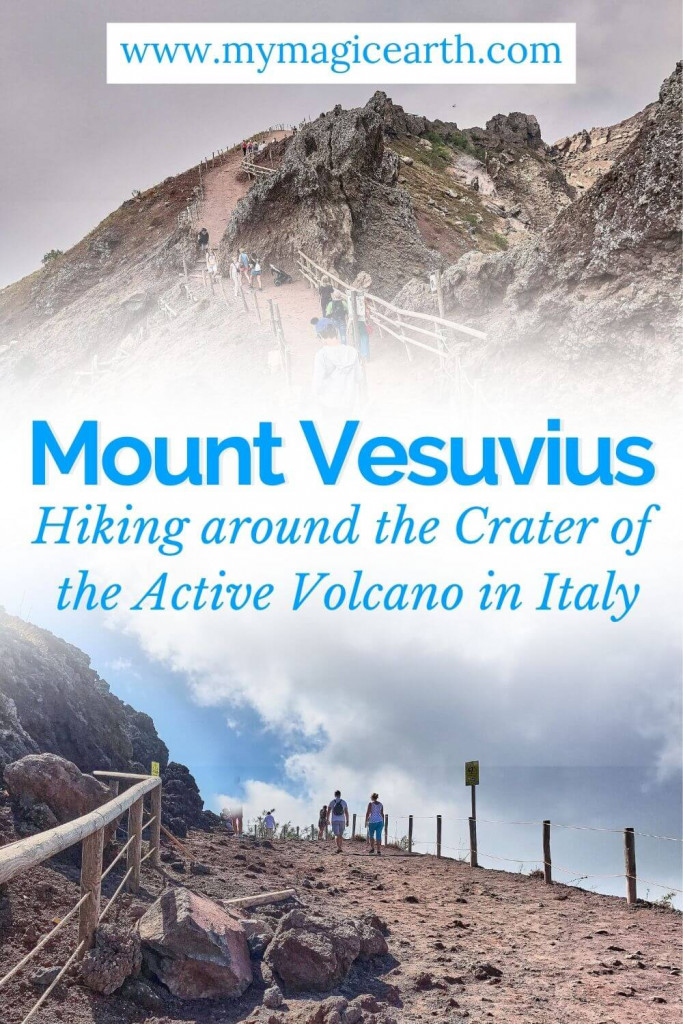

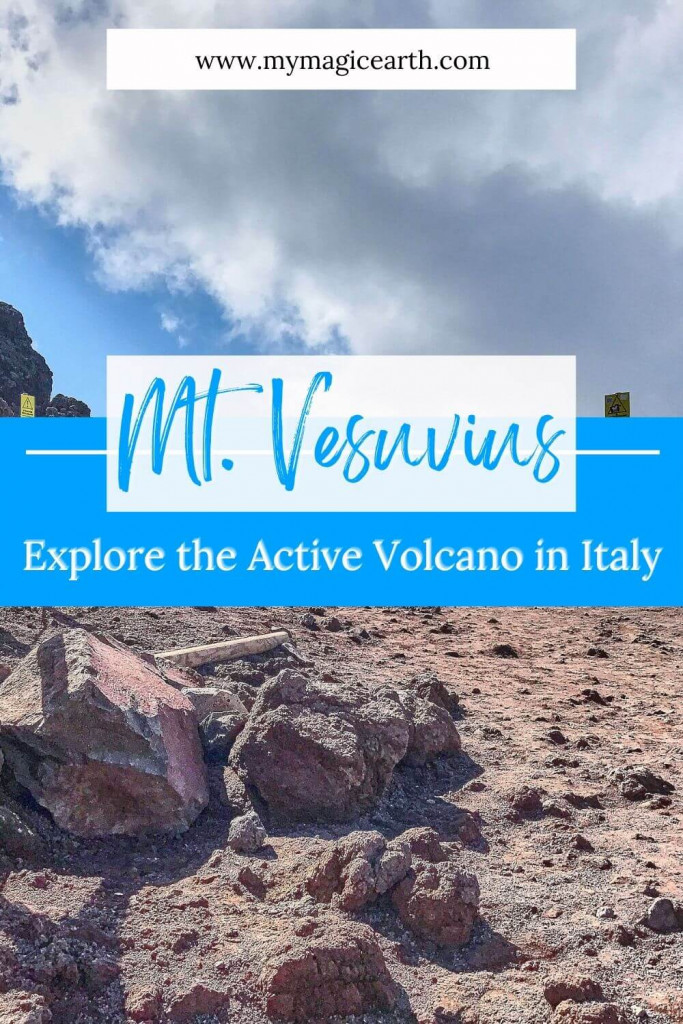

What a cool experience! I’ve been to Italy and seen Mt. Vesuvius from a distance, but I would love to climb up it one day!
Gorgeous pictures, I’d love to do this hike. I was in Hawaii last year right after the big island eruption, you could see the new land forming/expanding the coastline from the lava. SO COOL.
This would be such a cool thing to do. I’ve been to Pompeii but not to the actual volcano.
I’ve always wanted to go to Vesuvius and that climb looks like fun! :o)
My husband is a huge geology buff – he studied it in college. So volcanoes are his thing, especially ones like Mount Vesuvius. It’s nice they have a restaurant on its slope with tasty but inexpensive wine.
I might just have my heart in my mouth if I have to walk around the crater. Especially if I were smelling some sulphur. In any case, I guess I still want to go. You have put together your narration pretty well, giving us tips along the way. Those really give you a real picture of the place. And yes, I might sign up for seeing Pompeii too, along the way.
I always regret for not having planned to visit Mt Vesuvius, I toured Pompeii watched this mountain from a distance. Very daring of you to go one this trek with injured leg. 1euro for renting stick?!!! Pictures are great, they give a good idea of the place.
My husband and I did a day trip out to Mt. Vesuvius for his birthday trip and loved it! I will agree the ticketing was very confusing, so I am glad you wrote a detailed guide to help people navigate it and get to the top. Hiking around the crater is a great way to experience living history and get some exercise in for the day. I saw so many people in ridiculous shoes, one girl in heels even twisted her ankle so thanks for recommending suitable shoes there are the end! I loved your photos.
It’s interesting to know that tickets seem to be sold by one person on the side of the road. This sounds like such a cool experience. A meal at Terrazza Due Golfi with those views would be amazing too!
I have to admit I didn’t even know visitors could walk around the crater and around the volcano here. I am going to this area of Italy in the summer so now I know this, i might make the trip here as I do love a good hike now and again. And to be honest, I never hiked up a volcano before so that will be a first for me.
Even though we live half the year in Italy, I’ve still not made it to see Vesuvius. This sounds like an incredible trip and a tiring one too! I appreciate the tips about how you got there, as well as the facilities. Your photos of the crater are marvellous!
We loved the chance to visit Mt Vesuvius when we stayed in Sorrento. I do remember that hike to the top. But boy was the climb worth it for the views out over the Amalfi Coast. It was a bit spooky to see steam leaking out of the crater. We too found it amazing that so many people live in the lee of the volcano. This is still a zone of potential eruption. It always makes me think how optimistic the people are.